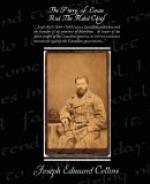The morrow’s sun revealed a strange spectacle. The great amplitude of rich, green grasses, warmed and beautified by the petals of flowers was as a ploughed field. The herbage had been literally crushed into mire, and this the innumerable hoofs had churned up with the soft, rich, dark soil of the prairie. The leguminous odours from decaying clover, and rank, matted masses of wild pease, the feverish exhalations of the tiger-lily, and of the rich blooded “buffalo lilac,” together with the dank, earthy smell from the broken sod, were disagreeable and oppressive. Lord Selkirk’s heart sank within him at seeing the ruin.
“I fear me,” he said, “to plant a colony here. A herd of these beasts coming upon a settlement would be worse than ten thousand spears.” But some of his guides had before seen the impetuous rushing of the herds, and they assured him that this might not occur again in this portion of the prairie for a quarter of a century to come.
“At any rate,” they persisted, “the buffalo keeps away from regions that send up chimney-smoke. The chief regret by-and-by will be that the herds will not come near enough to us.” And the Earl was reassured and proceeded with the steps preliminary to founding the colony. It need not be said that the place we have been describing was the prairie on the banks of the Red River.
In a little while ships bearing numbers of sturdy Scotchmen began to cross the sea bound for this famous colony, where the land was ready for the plough, and mighty herds of wild cattle grazed knee-deep among gorgeous flowers and sweet grasses. They brought few white women with them, the larger number being young men who had bade their “Heeland” lassies good-bye with warm kisses, promising to come back for them when they had built homesteads for themselves in the far away wilds of the West.




